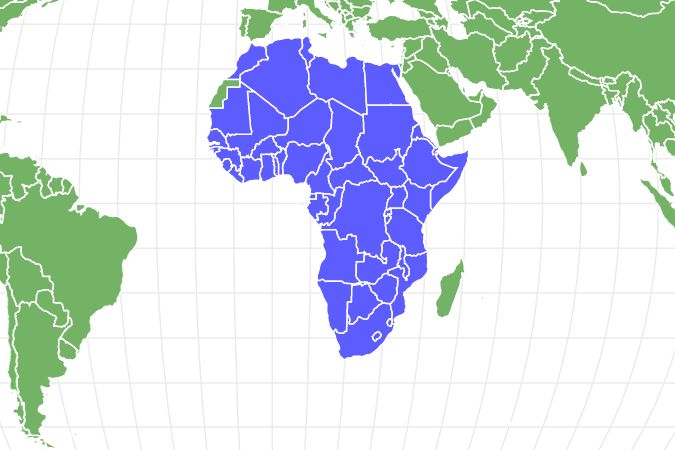Zonkey
Equus zebra x Equus asinus
The offspring of Zebra and Donkey parents!
Advertisement
Zonkey Scientific Classification
- Kingdom
- Animalia
- Phylum
- Chordata
- Class
- Mammalia
- Order
- Perissodactyla
- Family
- Equidae
- Genus
- Equus
- Scientific Name
- Equus zebra x Equus asinus
Read our Complete Guide to Classification of Animals.
Zonkey Conservation Status
Zonkey Facts
- Prey
- Grasses, Herbs, Fruit
- Name Of Young
- Foal
- Group Behavior
- Herd
- Fun Fact
- The offspring of Zebra and Donkey parents!
- Estimated Population Size
- Not known
- Biggest Threat
- Habitat loss and commercial breeding
- Most Distinctive Feature
- Unique stripes darkest on belly and legs
- Other Name(s)
- Zedonk, Zebrass, Zenkey
- Gestation Period
- 12 months
- Habitat
- Savanna and open woodland
- Diet
- Herbivore
- Lifestyle
- Diurnal
- Common Name
- Zonkey
- Number Of Species
- 1
- Location
- Africa, Zoos
- Slogan
- The offspring of Zebra and Donkey parents!
- Group
- Mammal
Zonkey Physical Characteristics
- Color
- Brown
- Grey
- Tan
- Skin Type
- Fur
- Top Speed
- 35 mph
- Lifespan
- 15 - 25 years
- Weight
- 227kg - 318kg (500lb - 700lbs)
- Height
- 1m - 1.5m (3.5ft - 5ft)
- Age of Sexual Maturity
- 1 - 2 years
- Age of Weaning
- 5 - 10 months
View all of the Zonkey images!
The world of hybrid animals is fascinating and bizarre. While hybrid animals can appear in the wild, it’s a rare occurrence. Hybrid animals are usually created through controlled crossbreeding at specialized farms or zoos. One of the popular hybrid animals that have stirred the curiosity of many animal lovers is the Zonkey–an animal created by breeding a male zebra and a female donkey.
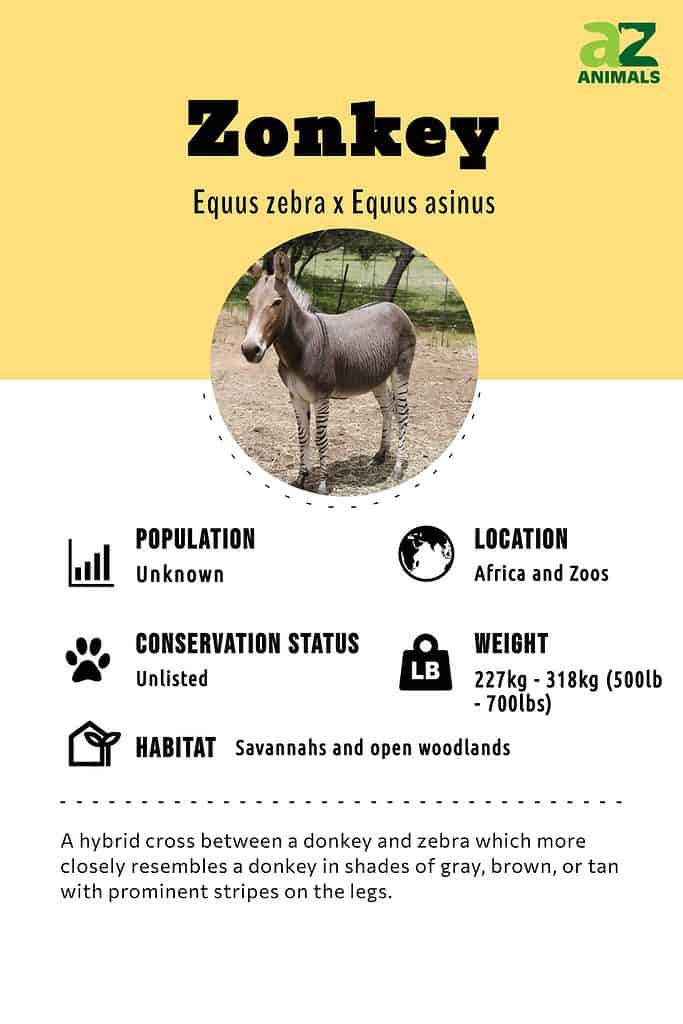
Classification
The Zonkey is a hybrid animal that is created by cross-breeding two different species of animal that belong to the same genetic group.
Technically though, an individual is only classed as a Zonkey if it is sired from a male Zebra and female Donkey, as one that has a male Donkey and female Zebra parents are known as a Zedonk. Like many other animal hybrids around the world including the Mule and the Liger, however, the Zonkey is a sterile animal meaning that it cannot produce offspring of its own. The Zedonk is also sterile. Unlike the Liger though, Zonkeys can live in the wild as Zebras and Donkeys are naturally found in close proximity to one another in parts of Africa. Although they are very rare, cases of wild Zonkeys have been reported but the majority of them today are found in zoos around the world and are bred as tourist attractions.
Evolution
As far as the evolution of the Zonkey goes, there’s not too much to tell. This species was mentioned by Charles Darwin in his world-changing “Origin of Species,” which was written in 1859. This is recorded proof that they were in existence at that point in history. Dated earlier, a man named Lord Morton cross-bred horses around 1815. So zonkey hybrids have existed in captivity at least since the 19th century.
The zonkey doesn’t occur often in the wild, likely due to chromosomes. While a donkey has 62 chromosomes, the zebra has 44-62 based on the particular species. This difference in numbers between males and females results in female offspring who have poor fertility and male offspring who are sterile–an anomaly termed Haldane’s Rule.
Types of Zebroids
There are no sub-species of Zonkey, but below is a list of Zebroids–zebras crossed with other members of the horse family:
- Zonkey (Equus zebra x Equus asinus) – Other names: zebonkey, zebrinny, zebrula, zebadonks. Created by cross-breeding a male zebra and female donkey. Unlisted by the ICUN.
- Zedonk (Equus zebra × Equus asinus) – Other names: zebrass, zebronkey, zebadonk, zenkey or deebra. Created by cross-breeding a male donkey and female zebra. Unlisted by the ICUN.
- Zorse (Equus zebra x Equus caballus) – Other names: zebra mule, zebrule, golden zebra. Created by cross-breeding a male zebra and female horse.
- Hebra (Equus zebra x Equus caballus) – Cross between a male horse and female zebra.
- Zony (Equus zebra x Equus equine) – Created by cross-breeding a male horse with a female pony.
- Zetland (Equus zebra x Equus caballus)– Created by cross-breeding a male horse and a female Shetland pony.
- Zebrass (Equus zebra x Equus asinus) – Created by cross-breeding a male horse and any ass (jenny) species.

A zebroid is any member of the horse family cross-bred with a zebra.
©Shllabadibum Bubidibam/Shutterstock.com
Anatomy and Appearance
The Zebra and the Donkey are closely related to one another and both belong to the Horse family means these two species share several similar characteristics including their size. The Zonkey tends to be of a similar size to these animals but takes on a more definitive Donkey-like appearance, with the obvious exception of inheriting the uniquely-striped pattern on their fur from their Zebra parent. Zonkeys and Zedonks (donkey father and zebra mother) are animals that tend to be either tan, brown, or grey in color with a lighter underside, and it is on the lighter parts of their body like their legs and belly where the Zonkey’s darker stripes are most prominent (they are much harder to see on the darker parts). The Zonkey also has a black mane that extends along the ridge of its back to the tip of its black tail, and a large head and ears which makes the Zonkey look much more like a Donkey than a Zebra.
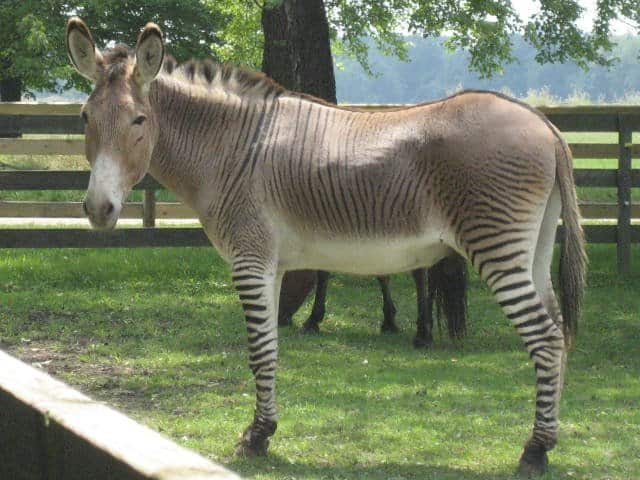
A Zonkey takes on the general appearance of a mule but with stripes that are most prominent on its legs.
Distribution and Habitat
Out of the three species of Zebra that are found living on the African continent, two are found in Eastern Africa whilst the other is found in more southern regions. Generally preferring to inhabit savannas and open woodlands throughout their historical range, Zebras are often found in enormous herds, particularly on the Serengeti plains where they migrate thousands of miles following the rains that bring new grass. Some are also found in close proximity to human settlements where they are known to have to compete with domestic livestock, such as Donkeys, for food. It is in these areas where Zonkeys are most likely to be produced naturally in the wild as it allows the two separate species to mate. Sadly, however, the world’s Zonkeys tend to be found in zoos and animal institutions where they are generally bred deliberately.
Behavior and Lifestyle
Despite being very similar animals both in appearance and behavior, zebras have not been domesticated like donkeys have. Humans have utilized donkeys for thousands of years for work and other purposes, but zebras have not been tamed because of their more aggressive nature. The Zonkey not only inherits the stripes of the zebra but also its wild streak. One of the Zonkey’s most favorable characteristics is its sheer power–a combination of the stamina of the Donkey mixed with the speed and strength of the Zebra. This gives the zonkey skills that can make it a valuable work animal that can pull heavy loads.

One of the Zonkey’s best characteristics is its inherited stamina from the Donkey and speed and strength from the Zebra.
©Shllabadibum Bubidibam/Shutterstock.com
Reproduction and Life Cycles
A male Zebra must be mated with a female Donkey for a Zonkey to be produced. If the sexes are switched, the offspring is a Zedonk. The gestation period can last for more than a year, and then the female Donkey births a single Zonkey foal. Like Zebra and Donkey foals, this foal is also able to stand up just minutes after birth. The Zonkey foal remains with its mother for five to six months of age, at which point it becomes independent and joins another herd. This kind of behavior happens a bit later with Zebra foals, which can take up to four years to leave the herd. Like numerous other hybrid animals, the Zonkey can’t produce offspring of its own, as the cross-breeding of two different species often results in their young being sterile and unable to continue a population.
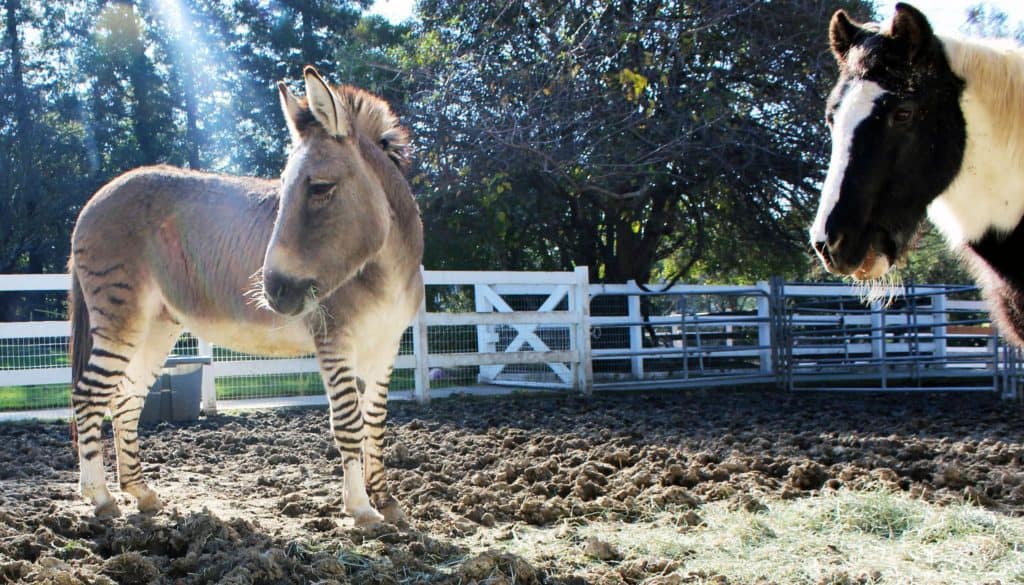
The zonkey can’t produce offspring of its own since the cross-breeding of two different species often results in their young being sterile.
Diet and Prey
Like Donkeys, Zebras, Horses, and their other relatives, Zonkeys are herbivorous animals meaning that they survive on a diet that is solely comprised of plant matter. The majority of their food is made up of grasses and herbs that grow on the ground and like all equines, the Zonkey has flat, broad teeth which are the perfect tools for grinding down the fibrous grass. Along with grazing, Zonkeys also like to browse for other types of food including fruits and berries which are found growing more common in less arid areas. Due to the fact that Zonkeys are naturally found in the African wilderness, there is always competition for both food and water from other animals inhabiting the same area and so they are always on the move in search of greener pastures.
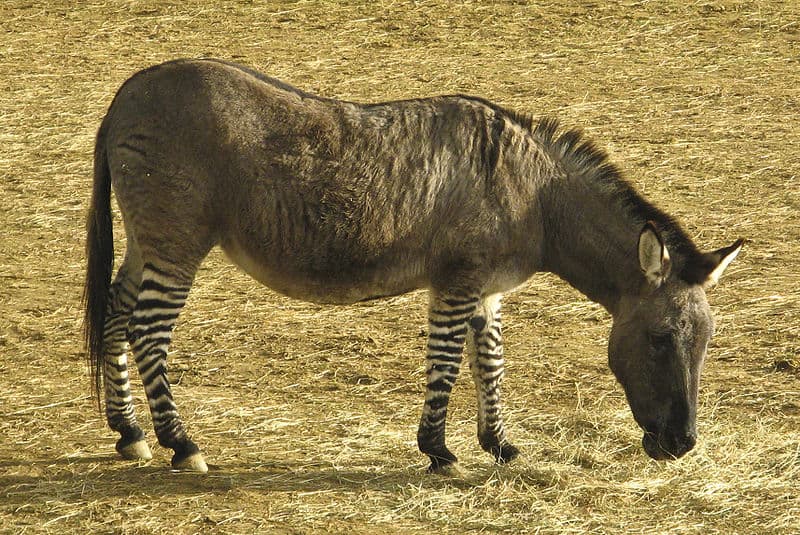
Zonkeys are herbivorous animals which graze on grasses and herbs that grow on the ground.
Zonkey Predators and Threats
Despite their large size and the fact that they are long-living animals, both Zebras and Donkeys (and therefore Zonkeys) are important prey to numerous carnivores throughout their natural range. Lions and Hyenas are their most common predators, along with African Hunting Dogs and large felines like Leopards and Cheetahs. Even though they remain a stable food source for these large predators, they are often hard to catch and Zebras particularly are known to protect wounded individuals to prevent them from being hurt anymore. Although rarer today, one of the biggest threats to both Zebras and Donkeys in Africa has been the fact that they have been subjected to hunting for both their meat and their skins. They are also being pushed into more isolated regions of their natural habitats meaning a decrease in the likelihood of wild Zonkeys.
Interesting Facts and Features
Although we often only think of Donkeys as being domesticated animals, wild herds of Donkeys can still be found living on the continent and in herds up to 100 strong in northern Africa, but this is an area that is not inhabited by Zebras and so the chances of a Zonkey occurring under these conditions would be extremely rare. Zonkeys have been mentioned by naturalists for centuries including Darwin who mentioned the possibility of a fertile female Zonkey that was being exhibited at the London Zoo. The Zonkey is thought to be a popular work animal as they have an apparent resistance to certain pests and diseases, something which is thought to have been inherited from their Zebra father.

While wild donkey herds do exist in Africa, the chances of them mating with zebras naturally are rare.
©Nevit Dilmen, CC BY-SA 3.0, via Wikimedia Commons – License
Relationship with Humans
Originally bred by Humans to pull heavy loads and thought to have appeared in zoos in the 19th century, the Zonkey first became famous when one was accidentally sired in Colchester Zoo in the 1970s, and they have since continued to exhibit Zonkeys as a popular tourist attraction. Along with now being bred in zoos around the world, Zonkeys are also bred for riding and as work animals involved in transport and pulling heavy loads due to their strength and stamina. In the wild in Africa however, Zebras have come under particular threat from people due to both hunting and loss of habitat for growing Human settlements or land clearance for agriculture.

The Zonkey became famous after one was accidentally sired in the Colchester Zoo in the 1970s.
Conservation Status and Life Today
Because the Zonkey is a cross-bred animal and cannot continue a population, it is not listed by the IUCN. The three Zebra species though are all listed with the Plains Zebra as Least Concern, the Mountain Zebra as Vulnerable, and the Grevy’s Zebra as Endangered. This means that the chances of Zonkeys occurring in the wild are becoming slimmer and slimmer, with the majority of them today found in zoos and used as work animals.
View all 14 animals that start with ZZonkey FAQs (Frequently Asked Questions)
Are Zonkeys herbivores, carnivores, or omnivores?
Zonkeys are Herbivores, meaning they eat plants.
What Kingdom do Zonkeys belong to?
Zonkeys belong to the Kingdom Animalia.
What class do Zonkeys belong to?
Zonkeys belong to the class Mammalia.
What phylum to Zonkeys belong to?
Zonkeys belong to the phylum Chordata.
What family do Zonkeys belong to?
Zonkeys belong to the family Equidae.
What order do Zonkeys belong to?
Zonkeys belong to the order Perissodactyla.
What type of covering do Zonkeys have?
Zonkeys are covered in Fur.
What genus do Zonkeys belong to?
Zonkeys belong to the genus Equus.
Where do Zonkeys live?
Zonkeys live in Africa and zoos.
In what type of habitat do Zonkeys live?
Zonkeys live in savannas and open woodlands.
How fast is a Zonkey?
A Zonkey can travel at speeds of up to 35 miles per hour.
Thank you for reading! Have some feedback for us? Contact the AZ Animals editorial team.
Sources
- David Burnie, Dorling Kindersley (2011) Animal, The Definitive Visual Guide To The World's Wildlife
- Tom Jackson, Lorenz Books (2007) The World Encyclopedia Of Animals
- David Burnie, Kingfisher (2011) The Kingfisher Animal Encyclopedia
- Richard Mackay, University of California Press (2009) The Atlas Of Endangered Species
- David Burnie, Dorling Kindersley (2008) Illustrated Encyclopedia Of Animals
- Dorling Kindersley (2006) Dorling Kindersley Encyclopedia Of Animals
- David W. Macdonald, Oxford University Press (2010) The Encyclopedia Of Mammals
- Hybrid Animals, Available here: http://www.hybrid-animals.com/
- Zonkey Information, Available here: http://www.buzzle.com/articles/zonkey-information.html
- Donkey Facts, Available here: http://www.honoluluzoo.org/donkey.htm
- About Zebras, Available here: http://www.outtoafrica.nl/animals/engzebra.html

